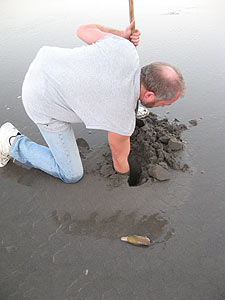 |
Follow Oregon Coast updates at ![]()
Crabbing, Low Tides and Whales are Hot on Coast, Say Oregon Officials
Published 12/22/2011

(Oregon Coast) – There is good news for crabbers and whale watchers along the Oregon coast in December, according to the latest recreation report issued by Oregon Department of Fish and Wildlife (ODFW) (above: Rockaway Beach).
Meanwhile, some awesome low tides are coming up. ODFW said until December 28 there will be some major minus tides. These are in the late afternoons, around 4 p.m. to 6 p.m., and as low as nearly minus two feet, with most around minus one foot or so. (See more tides on the individual weather pages)
Crabbing in Oregon coast bays was excellent in November, according to ODFW. Large male crabs filled out nicely this season and made for good catches. Many crabbers were able to catch limits near Astoria and around Waldport.
 |
| Clamming will be excellent along the Oregon coast with the coming minus tides. |
ODFW had no updates for Tillamook Bay, Netarts Bay or Coos Bay at this time.
Sport crabbing on the ocean opened up again on December 15 after a long than usual delay – just nort of Gold Beach, however. It's still closed from Gold Beach down to the California border, but the central and north coast areas – like Florence, Newport, Tillamook, Manzanita or Warrenton – are wide open again.
The closed portion of the coast will open again on January 15.
ODFW offered some interesting facts about the Whale Watch Week next and the annual winter migration, including the fact that because the weather has been so calm and clear along the coast spotting them has been easy. There are more of them now as well, because the migration has already begun, and those two elements allowed the Whale Watch Center in Depoe Bay to report seeing nine whales on one day last week.
“A few of them were only one to two miles offshore.” ODFW said.
According to ODFW, this winter migration is fairly quick and short, usually only about four weeks. They disappear in mid-January.

Low tides coming to Cannon Beach, other spots (photo of Haystack Rock courtesy Seaside Aquarium).
“A gray whale's blow is up to 15 feet high, and each blow is visible for about five seconds,” ODFW said. “When warm, moist air exhaled from the animals' lungs, meets the cool air at the ocean surface, it creates the bushy column called a blow, or spout. Anticipate that the whale will dive for three to six minutes, then surface for three to five blows in row, 30 to 50 seconds apart, before diving deep for three to six minutes again.”
ODFW said Gray whales are the one species that tends to stick closest to shorelines, usually found within a few miles of land as they trek. The west coasts of the U.S., Canada and Mexico are particularly lucky in this regard, as the only other place on Earth where whales live so close to shore is near Korea.

Whale photo courtesy Whale Watch Center, Depoe Bay.

Cape Kiwanda, Pacific City
More About Oregon Coast hotels, lodging.....
More About Oregon Coast Restaurants, Dining.....
 |
 |
 |
LATEST OREGON COAST NEWS STORIES
Oregon Coast, Valley and Likely Washington Coast to Get Some Aurora Borealis ... |
Back to Oregon Coast
Contact Advertise on BeachConnection.net
Secrets of the Season |
Unusual Travel Articles TravelParanormal.com allows you to submit your own creepy tale or debunk one - or see up-to-the-minute news headlines about travel and the paranormal. News Headlines from All Over Oregon Need to scan Oregon headlines? Constantly updated news from all over Oregon: a comprehensive, up-to-the-minute display of news headlines from a variety of media |




































